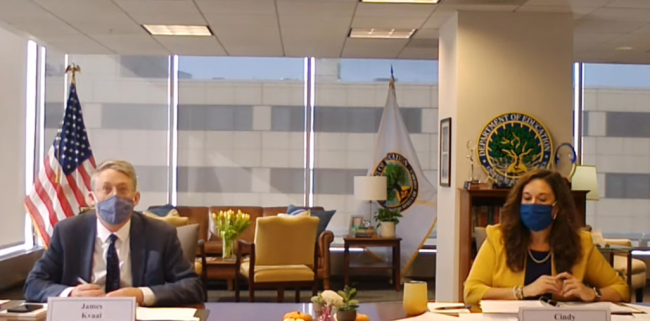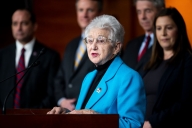You have /5 articles left.
Sign up for a free account or log in.

Under Secretary James Kvaal testifies before Congress alongside Deputy Secretary Cindy Marten.
House Education and Labor Committee
The three rounds of COVID-19 relief funds for higher education passed by Congress in 2020 and early 2021 have had a “significant impact on students and institutions” and made a “tremendous difference,” Department of Education under secretary James Kvaal told lawmakers Wednesday.
The House Education and Labor Committee held a subcommittee hearing to conduct oversight of how institutions have been using the $76 billion invested in the Higher Education Emergency Relief Fund (HEERF). Kvaal said the funds helped students stay enrolled in college, helped institutions meet public health needs and avoid mass layoffs, and kept some private and public nonprofit colleges from closing.
“HEERF has had a real impact on students, on their colleges,” Kvaal said. “For example, I recently received a letter from President Daniel Phelan of Jackson College in Michigan describing how HEERF helped pay for student tuition and fees, food, housing, course materials, medical and mental health care, and childcare.”
A recent survey of 400 college presidents conducted by the American Council on Education found that HEERF funds allowed 93 percent of colleges to provide emergency scholarships to students, 88 percent of colleges to purchase COVID-19 tests and meet other public health needs, 80 percent of colleges to provide students with electronic devices and internet access to keep them enrolled, 70 percent of colleges to continue to employ faculty and staff at risk of unemployment, and 18 percent of colleges at risk of closing to continue operating.
At least half of the HEERF funds provided to institutions were required to be used on emergency aid to students. Kvaal noted that more than seven million students were able to take advantage of $6 billion in emergency grant aid, with each student receiving an average of $850.
As of last Friday, colleges have spent 65 percent of their total HEERF student funds and 54 percent of their total HEERF institutional funds. Those percentages continue to rise every week and do not include commitments that colleges and universities have already made for their remaining HEERF dollars but have yet to use, said Kvaal.
Several lawmakers expressed concerns about how the department was ensuring that institutions are using funds for their intended purpose, as prescribed by law.
“The investments we delivered to colleges and universities provided a lifeline to students and may have prevented the financial collapse of our higher education system,” said Representative Frederica Wilson, a Democrat from Florida and chair of the Higher Education and Workforce Investments subcommittee. “The Education Department must continue to ensure that institutions are using this funding responsibly to support their students, faculty and staff, and that states are holding up their end of the bargain by maintaining their investments in higher education.”
The top Republican on the higher education subcommittee, Representative Greg Murphy of North Carolina, said that as recipients of government funds, institutions of higher education are not exempt from congressional oversight and accountability, because taxpayers deserve to know how those funds are being spent.
“It is Congress and this department’s responsibility to ensure that colleges and universities spend taxpayer dollars in a way that helps students—not hire more administrators or grow more nonacademic programs—which is why I’m happy that we are having this hearing today,” Murphy said. “Unfortunately, however, I share the concern of many of my colleagues that the department is too focused on implementing their progressive wish list and attacking colleges based upon their tax status to carry out their necessary oversight.”
According to Kvaal, the department has taken steps to ensure the proper use of HEERF funds by publishing clear, comprehensive guidance; creating quarterly and annual reporting requirements; working with the Office of Management and Budget to designate the funds as high-risk so that they’ll be prioritized by auditors; imposing additional oversight for colleges that are “financially risky”—otherwise known as those under Heightened Cash Monitoring 2; imposing additional audit requirements on grantees that weren’t otherwise required to conduct audits; and requiring for-profit college presidents and major owners to sign certification forms indicating that they’re aware of all the requirements for the funds.
“We have worked very hard to make sure all colleges are spending funds within the allowable uses outlined by Congress,” Kvaal said.








